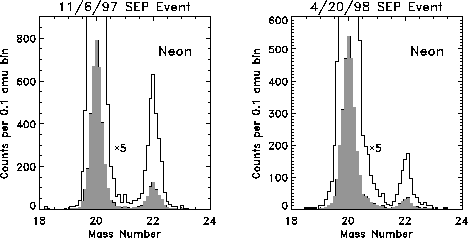

It has been known for almost thirty years that the abundances of the elements in solar energetic particles (SEPs) vary from event to event, but until recently there has been little information on whether the isotopic composition of SEPs also varies, at least for heavy elements with atomic number Z >= 6.
Shortly after the launch of ACE, a large SEP event on Nov. 6, 1997, provided an opportunity for the Solar Isotope Spectrometer (SIS) on ACE to measure the isotopes of a number of heavy elements (ACE News #5). The figure above shows neon isotope data between ~22 and ~100 MeV/nucleon from the 11/6/97 event and from another large SEP event on 4/20/98. In the Nov. 6 event the 22Ne/20Ne ratio is ~0.15, while in the April 20 event this ratio is only ~0.05, about a factor of three less.
Neon is a volatile element that is depleted in terrestrial and meteoritic material. Studies of neon trapped in meteorites have identified several components with distinct isotope abundance patterns. Neon-A, thought to be a primordial component, has 22Ne/20Ne = 0.122. This component was chosen by A.G.W. Cameron for his tables of abundances that were the standard reference for solar system composition for three decades after the first version was published in 1959. A second lunar and meteoritic component, Neon-B, is thought to represent implanted solar wind, since its composition is close to the value of 22Ne/20Ne = 0.073 measured directly in the solar wind on the Apollo lunar missions. Most experts now believe that neon in the Sun has a 22Ne/20Ne ratio close to that observed in the solar wind. A third component, Neon-C, with 22Ne/20Ne ~ 0.089, is of unknown origin but has been interpreted as due to implanted SEPs with energies <0.1 MeV/nucleon.
Early measurements of 22Ne/20Ne in SEPs using instruments that were the forerunners of SIS were more consistent with Neon-A than with solar wind neon. More recently, measurements from SAMPEX in 1992 favored the solar wind value, or possibly Neon-C, rather than Neon-A. The new results from ACE clearly show that the isotopic composition of SEPs can vary from event to event, as demonstrated above. While there is not yet sufficient data to say whether the long term 22Ne/20Ne ratio in SEPs agrees with that of Neon-C, it is clear that the isotopic composition of Ne in SEPs can differ greatly from the composition observed in the solar wind at particle energies that are ~10,000 times lower. We are now investigating how variations in the isotopic composition of about a dozen elements are related to concurrent variations in the elemental composition of SEP events observed by SIS to date.
Contributed by Richard Mewaldt and Rick Leske of Caltech.
See The SIS Home Page for more information about the SIS instrument.
Last modified 30 September 1998,
Andrew Davis
Return to ACE homepage.
/ACE/